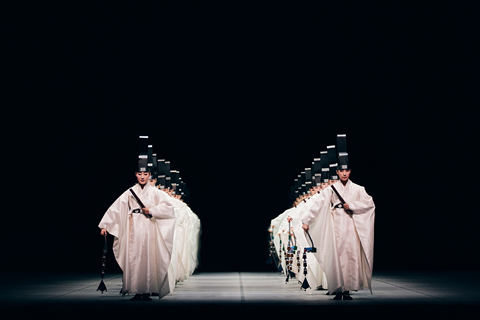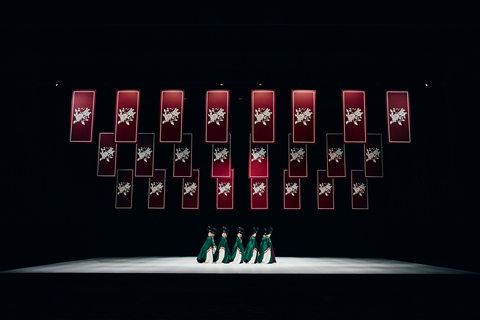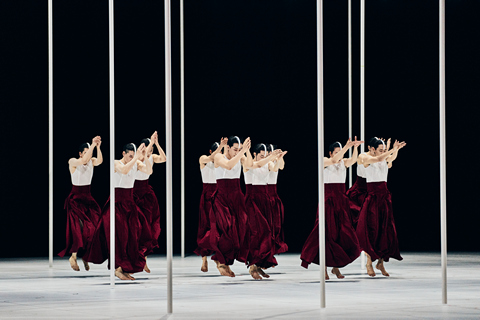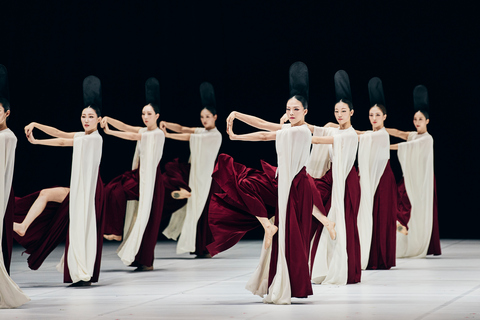Seoul Metropolitan Dance Theatre: One Dance
A beautifully staged program of Korean dance by the Seoul Metropolitan Dance Theatre: that needed more variation.

Seoul Metropolitan Theatre’s “One Dance, Act 1” at the David H. Koch Theater (Photo credit: Hwang Piljoo)
[avatar user=”Joel Benjamin” size=”96″ align=”left”] Joel Benjamin, Critic[/avatar]
Korean Arts Week celebrated the theatrical and fine arts of South Korea, a culture under-represented in New York City compared to, say, those of Japan, China and India.
At the David H. Koch Theater at Lincoln Center, the Seoul Metropolitan Dance Theatre performed One Dance, a celebration of historic formal, ritual dance forms of Korea. Although One Dance certainly had theatrical viability and a great number of performers, the problem of placing religious and ethnic rituals onto a proscenium stage and presenting them before an audience of three thousand wasn’t completely solved.

Seoul Metropolitan Theatre’s “One Dance, Act 2” at the David H. Koch Theater (Photo credit: Hwang Piljoo)
One Dance was divided into four sections. Act 1 was called “Study of Ilmu.” This Act, itself, was divided into four segments, alternating the classical choreography with variations. Each performed mostly in two lines of dancers perpendicular to the front of the stage. At first they stood still, moving only their arms gently, in their hands props that exaggerated their arm gestures.
Soon they shuffled into a different formation, but continued the soft-edged, rounded arm arrangements. The third and fourth movements proceeded elegantly, but repetitively.
Act 2, “Study of Gungjungmu,” featured the best moment in the show when the colorful mats that each dancer performed on slowly rose into a lovely formation aloft, the red mats contrasting beautifully with the mostly green costumes. Otherwise, this court and courtly dance, almost totally performed in unison, revealed choreographer and artistic director Hyejin Jeong’s incredible ability to handle a stage-full of disciplined dancers.

Seoul Metropolitan Theatre’s “One Dance, Act 3” at the David H. Koch Theater (Photo credit: Hwang Piljoo)
Act 3, “Jukmu” introduced the male contingent of the thirty-nine-member troupe. They used long poles in decorative ways that looked like slow-motion martial arts.
Act 4, “Sin-Ilmu (New Ilmu),” the final portion of the evening was in two parts, each labeled “The New Tradition.” The music was less subdued—drumming and clanging—and, for the first time in One Dance there was some jumping, mostly joyful little leaps that faded into ever more unison dancing.

Seoul Metropolitan Theatre’s “One Dance, Act 4” at the David H. Koch Theater (Photo credit: Hwang Piljoo)
One Dance did have a great deal going for it: There’s always something rousing about seeing large ensembles on stage. (Audiences, including this one, love applauding large group efforts.) The ethnic-styled costumes were sumptuous and colorful. (Costumes credited to Kuho Jung.) The dancers were disciplined and lovely to watch. The lighting by Sun Hong Min was spectacular, especially an arrangement of neon-like tubes that kept changing positions, framing the choreography, also credited to Kuho Jung plus Sung Hoon Kim and Jaeduk Kim.
Was the clearly appreciative audience giving an ovation for the artistry or effort of this elegant dance troupe?
For those whose interests are more inclined toward the visual arts, “Discovery: 12 Contemporary Artists from Korea” is on exhibit through August 27th on the Rink Level of Rockefeller Center.
Seoul Metropolitan Dance Theatre: One Dance (July 20-22, 2023)
Lincoln Center’s Summer for the City Korean Arts Week
David H. Koch Theater, 20 Lincoln Center Plaza, Columbus Avenue and 63nd Street, Lincoln Center, in Manhattan
For tickets, call 212-496-0600 or visit http://www.davidhkochtheater.com
Running time: 70 minutes without an intermission






Leave a comment